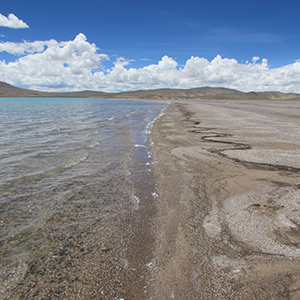Sub-fossil chironomids as indicators of hydrological changes in the shallow and high-altitude lake Shen Co, Tibetan Plateau, over the past two centuries

Accepted: 20 July 2022
Supplementary: 178
HTML: 130
All claims expressed in this article are solely those of the authors and do not necessarily represent those of their affiliated organizations, or those of the publisher, the editors and the reviewers. Any product that may be evaluated in this article or claim that may be made by its manufacturer is not guaranteed or endorsed by the publisher.
Authors
Understanding climate and monsoonal dynamics on the Tibetan Plateau is crucial, as recent hydrological changes, evidenced by rising lake levels, will be accelerated by current global warming and may alter aquatic habitats and species inventories. This study combines chironomid assemblages with sedimentological, mineralogical and geochemical data of a short sediment core (37.5 cm) from the high-altitude (> 4,733 m asl), saline (9 g L-1) and shallow (~5 m water depth) Shen Co, located in the southern part of the central Tibetan Plateau. The predominantly littoral, species-poor (10 chironomid morphotypes) chironomid assemblages are dominated by salt-tolerant taxa, that are highly sensitive to lake level fluctuations and macrophyte vegetation dynamics, making them ideally suited for tracking lake level changes over time. Results indicate a period (from ca. 1830 to 1921 CE) of drier conditions with low runoff and high evaporation rates in the Shen Co catchment, as indicated by a dominance of low-Mg calcite and dolomite and increased Ca/Fe and Sr/Rb ratios. This resulted in a decline in lake levels, an increase in salinity and the periodic occurrence of desiccation events at the sampling site. The first chironomid morphotype to appear after the dry period is Acricotopus indet. morphotype incurvatus, which indicate still low (<2 m) but rising lake levels after 1921 CE due to increasing runoff and a lower evaporation/precipitation ratio, as reflected by coarser grain size, higher quartz content and increased TN, TOC and Al/Si ratios. A replacement of A. indet. morphotype incurvatus by Procladius is observed as lake level rise continued after 1950 CE. The highest lake level is proposed for the period since 2006 CE. From 1955 to 1960 CE and from 2011 to 2018 CE, the presence of the phytophilic taxon Psectrocladius sordidellus-type supported abundant macrophyte growth. These changes are consistent with climate reconstructions from the northern and central Tibetan Plateau, indicating warmer and wetter climate conditions since the beginning of the 20th century, which have led to an increase in lake level in a number of Tibetan lakes. Our study specifically highlights 1920 and 1950 as years with enhanced precipitation. This can be attributed to the strong, with overlapping multidecadal cycles of Westerlies and monsoon systems. This study demonstrates the significance of studying small, shallow lakes, as they frequently contain aquatic communities that respond more rapidly to the changes in the lake system. In addition, this study expands our understanding of the ecology of Tibetan chironomid morphotypes, highlighting this group’s potential as paleolimnological proxies for investigating past environmental and climatic changes.
Edited by
Diego Fontaneto, CNR-IRSA Water Research Institute, Verbania, ItalySupporting Agencies
Nam Co Observation and Research Station (NAMORS), International Research Training Group, Deutsche Forschungsgemeinschaft (DFG grant 317513741 / GRK 2309), Open Access Publication Funds of the Technische Universität BraunschweigHow to Cite

This work is licensed under a Creative Commons Attribution-NonCommercial 4.0 International License.
Similar Articles
- Mateja GERM, Tatjana SIMČIČ, Vitality of aquatic plants and microbial activity of sediment in an oligotrophic lake (Lake Bohinj, Slovenia) , Journal of Limnology: Vol. 70 No. 2 (2011)
- Oliver Skibbe, Nelida Abarca, Francine Forrest, Petra Werner, Exploring diatom diversity through cultures - a case study from the Bow River, Canada , Journal of Limnology: Vol. 81 (2022)
- Pavel Beracko, Andrea Kušnírová, Michaela Partlová, Jana Ciceková, Community structure, life histories and secondary production of stoneflies in two small mountain streams with different degree of forest cover , Journal of Limnology: Vol. 75 No. 1 (2016)
- Gianpaolo SALMOIRAGHI, Bruna GUMIERO, Andrea PASTERIS, Susanna PRATO, Carla BONACINA, Giuliano BONOMI, Breakdown rates and macroinvertebrate colonisation of alder (Alnus glutinosa) leaves in an acid lake (Lake Orta, N Italy), before, during and after a liming intervention , Journal of Limnology: Vol. 60 No. 1 (2001)
- Slawek Cerbin, Łukasz Wejnerowski, Marcin Dziuba, Aphanizomenon gracile increases in width in the presence of Daphnia. A defence mechanism against grazing? , Journal of Limnology: Vol. 72 No. 3 (2013)
- Francesca CIUTTI, Cristina CAPPELLETTI, First record of Corbicula fluminalis (Müller, 1774) in Lake Garda (Italy), living in sympatry with Corbicula fluminea (Müller, 1774) , Journal of Limnology: Vol. 68 No. 1 (2009)
- Martin SCHMID, Pema DORJI, Permanent lake stratification caused by a small tributary - the unusual case of Lej da San Murezzan , Journal of Limnology: Vol. 67 No. 1 (2008)
- Vanessa Virginia Barbosa, Juliana dos Santos Severiano, Dayany Aguiar de Oliveira, José Etham de Lucena Barbosa, Influence of submerged macrophytes on phosphorus in a eutrophic reservoir in a semiarid region , Journal of Limnology: Vol. 79 No. 2 (2020)
- Renato BAUDO, Anna OCCHIPINTI, Anna Maria NOCENTINI, Monica SABOLLA, Benthos of Lake Orta in the year 1996 , Journal of Limnology: Vol. 60 No. 2 (2001)
- Donald D. ADAMS, Renato BAUDO, Gases (CH4, CO2 and N2) and pore water chemistry in the surface sediments of Lake Orta, Italy: acidification effects on C and N gas cycling , Journal of Limnology: Vol. 60 No. 1 (2001)
<< < 46 47 48 49 50 51 52 53 54 55 > >>
You may also start an advanced similarity search for this article.
-
Paula Echeverría‐Galindo, Sonja Rigterink, Julieta Massaferro, Liseth Pérez, Bernd Wünnemann, Philipp Hoelzmann, Wengang Kang, Nicole Börner, Anja Schwarz, Andreas Laug, Ping Peng, Junbo Wang, Liping Zhu, Antje SchwalbJournal of Quaternary Science : 2023
-
Marco Bertoli, Gianguido Salvi, Rachele Morsanuto, Elena Pavoni, Paolo Pastorino, Giuseppe Esposito, Damià Barceló, Marino Prearo, Elisabetta PizzulDiversity : 2024

 https://doi.org/10.4081/jlimnol.2022.2077
https://doi.org/10.4081/jlimnol.2022.2077





